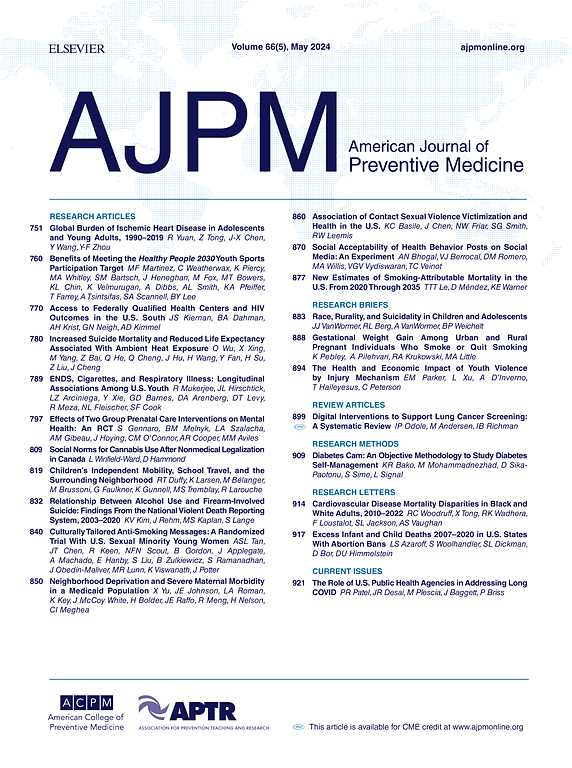Behavioral Responses to the Threat of Firearm Violence Among Colorado Adults
IF 4.5
2区 医学
Q1 MEDICINE, GENERAL & INTERNAL
引用次数: 0
Abstract
Introduction
Research examining the association between concerns about firearm injury and Americans’ behaviors is limited. The aim of this study was to describe the prevalence of self-reported behavioral responses to fear of firearm injury among Colorado adults.
Methods
Data are from the 2023 Colorado Firearm Injury Prevention Survey (N=1,517 adults included; data analyzed 2025). The primary outcome was engagement in any of 11 behavioral responses assessed using an item modified from the Kaiser Family Foundation Survey: Have you done any of the following to protect yourself or your family from the possibility of firearm-related violence? Behaviors were categorized into avoidance, communication, or firearm related. Weighted proportions and 95% CIs are reported. Survey weights account for nonresponse and ensure that findings are representative of Colorado adults.
Results
Among Colorado adults, 64.5% (95% CI=61.0%, 67.8%) reported engagement in at least 1 behavioral response; 40.8% (95% CI=37.4%, 44.4%) reported an avoidance behavior, 35.4% (95% CI=32.0%, 38.9%) reported a communication behavior, and 27.9% (95% CI=24.7%, 31.4%) reported a firearm behavior. Those who reported any changes were significantly more likely to identify as female or Hispanic, have children in the household, reside in a household with a firearm, and have experienced violence and were more likely to have reported concerns about firearm violence in their community and violence impacting themselves or their family than those who reported no changes.
Conclusions
A majority of Colorado adults report having changed their behaviors in response to the threat of firearm violence. Further work is needed to understand the broad impact of these behavior changes on the Colorado populace.
科罗拉多州成年人对枪支暴力威胁的行为反应。
导言:关于枪支伤害和美国人行为之间关系的研究是有限的。本研究的目的是描述科罗拉多州成年人对枪支伤害恐惧的自我报告行为反应的流行程度。方法:数据来自2023年科罗拉多州枪支伤害预防调查(n=1,517名成年人,分析数据2025)。主要结果是参与了11项行为反应中的任何一项,这些行为反应是根据凯撒家庭基金会调查中修改的一项来评估的:“你是否做了以下任何一项来保护你自己或你的家人免受枪支相关暴力的可能性?”行为被分为逃避、交流或与枪支有关。报告了加权比例和95%置信区间(CI)。调查权重说明无反应,并确保调查结果是科罗拉多州成年人的代表性。结果:在科罗拉多州的成年人中,64.5% (95%CI:61.0%-67.8%)报告参与了至少一种行为反应;40.8% (95%CI:37.4%-44.4%)报告了逃避行为,35.4% (95%CI:32.0%-38.9%)报告了沟通行为,27.9% (95%CI:24.7%-31.4%)报告了枪支行为。与那些报告没有变化的人相比,那些报告有变化的人更有可能是女性或西班牙裔,在家庭中有孩子,居住在有枪支的家庭中,经历过暴力,更有可能报告他们社区中的枪支暴力以及暴力对他们自己或家庭的影响。结论:大多数科罗拉多州的成年人报告说,他们已经改变了他们的行为,以应对枪支暴力的威胁。需要进一步的工作来了解这些行为变化对科罗拉多州民众的广泛影响。
本文章由计算机程序翻译,如有差异,请以英文原文为准。
求助全文
约1分钟内获得全文
求助全文
来源期刊

American Journal of Preventive Medicine
医学-公共卫生、环境卫生与职业卫生
CiteScore
8.60
自引率
1.80%
发文量
395
审稿时长
32 days
期刊介绍:
The American Journal of Preventive Medicine is the official journal of the American College of Preventive Medicine and the Association for Prevention Teaching and Research. It publishes articles in the areas of prevention research, teaching, practice and policy. Original research is published on interventions aimed at the prevention of chronic and acute disease and the promotion of individual and community health.
Of particular emphasis are papers that address the primary and secondary prevention of important clinical, behavioral and public health issues such as injury and violence, infectious disease, women''s health, smoking, sedentary behaviors and physical activity, nutrition, diabetes, obesity, and substance use disorders. Papers also address educational initiatives aimed at improving the ability of health professionals to provide effective clinical prevention and public health services. Papers on health services research pertinent to prevention and public health are also published. The journal also publishes official policy statements from the two co-sponsoring organizations, review articles, media reviews, and editorials. Finally, the journal periodically publishes supplements and special theme issues devoted to areas of current interest to the prevention community.
 求助内容:
求助内容: 应助结果提醒方式:
应助结果提醒方式:


